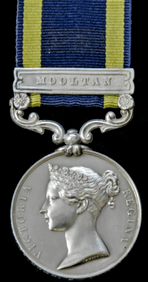Punjab Medal
| Punjab Medal | |
|---|---|
  Obverse and reverse of the medal. | |
| Awarded by United Kingdom of Great Britain and Ireland | |
| Type | Campaign medal |
| Eligibility | British and Honourable East India Company forces. |
| Awarded for | Campaign service. |
| Campaign(s) | Punjab 1848–49. |
| Description | Silver disk, 36mm diameter. |
| Clasps |
|
| Statistics | |
| Established | 2 April 1849 |
|
| |
The Punjab Medal was a campaign medal issued to officers and men of the British Army and Honourable East India Company who served in the Punjab campaign of 1848-49, which ended in the British annexation of the Punjab.[1]
The medal was approved on 2 April 1849, for award to all who served in the Punjab between 7 September 1848 and 14 March 1849.[2]
Description
- A circular silver medal, 36 millimetres (1.4 in) in diameter, designed by William Wyon.[2]
- Obverse: The diademed head of Queen Victoria with the legend VICTORIA REGINA.
- Reverse: A scene showing Sir Walter Gilbert receiving the Sikh surrender with the legend TO THE ARMY OF THE PUNJAB above, and below MDCCCXLIX, the year 1849 in Roman numerals.[1]
- Ribbon: The 31.7 millimetres (1.25 in) wide ribbon is dark blue with a yellow stripe towards each edge.[1]
Clasps
Three clasps were authorised, although no medals were awarded with more than two, since no unit qualified for both the Mooltan and Chilianwala clasps.[3] The medal was issued without a clasp to those who were present in the Punjab but did not take part in any of the principal battles.[3]
The three clasps awarded were:
- Mooltan
- 7 September 1848 – 22 January 1849. Awarded to troops engaged in the siege of Multan. In total, 18,967 of these clasps were awarded, 2,900 to Europeans and 16,067 to Indian troops.[4]
- Chilianwala
- 13 January 1849. Awarded to troops under the command of Lord Gough who engaged with the Sikh army of Sher Singh and Lal Singh near Chilianwala. In total, 21,453 of these clasps were awarded, 4,300 to Europeans and 16,153 to Indian troops. [4]
- Goojerat
- 21 February 1849. Awarded to troops under the command of Lord Gough who defeated the Sikh army of Sher Singh at Gujarat. In total, 32,960 of these clasps were awarded, 6,200 to Europeans and 26,760 to Indian troops. [4]
The clasps read downwards from the top of the medal, varying from the usual practice of placing the earliest clasp nearest the medal.[1]
Notes
Bibliography
- Mussel, J (ed) – Medals Yearbook – 2015, (2014), Token Publishing.
- Joslin, Litherland, and Simpkin (eds), British Battles and Medals, (1988), Spink